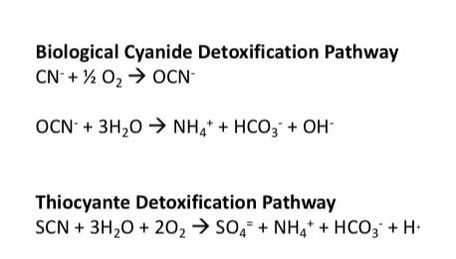While cyanide is toxic to many organisms, a large number of microbes have the ability to detoxify cyanide and actually use the carbon/nitrogen for growth. While multiple biological pathways exist, the most efficient is an aerobic pathway. Below are the chemical transformations for CN and SCN.

These cultures can be concentrated in shelf-stable form and added to systems with CN related shock or problems with stable CN removal. Once added the CN detoxification starts and the MLSS returns to a healthy state within days as respiration inhibition decreases. Once detoxified, both AOB & NOB return to normal ammonia and nitrite oxidiation rates.
Biological cyanide removal can produce CN concentrations in the ppb range at a lower cost than chemical oxidation or metal complexing options. While it cannot treat extremely high CN concentrations seen in some plating and mining wastes, most industrial high CN wastewater can be treated efficiently with biological treatment.

 RSS Feed
RSS Feed